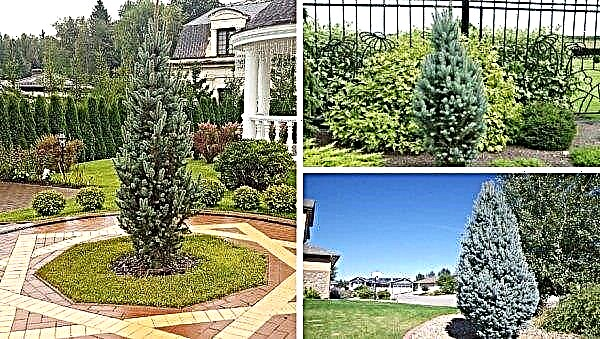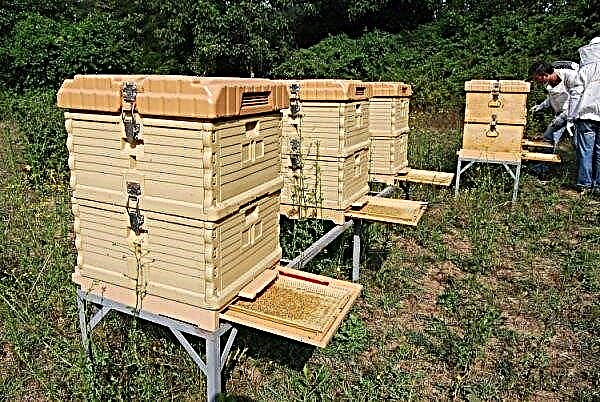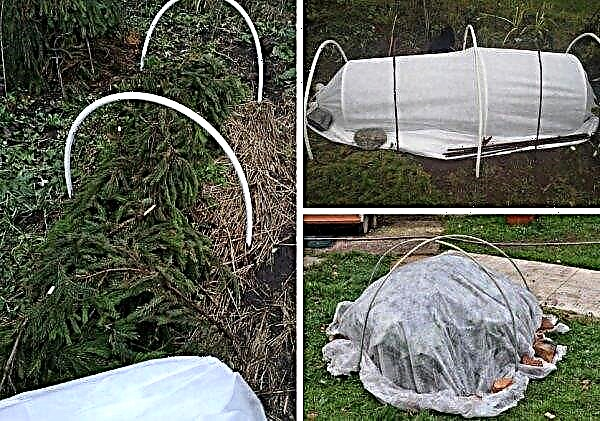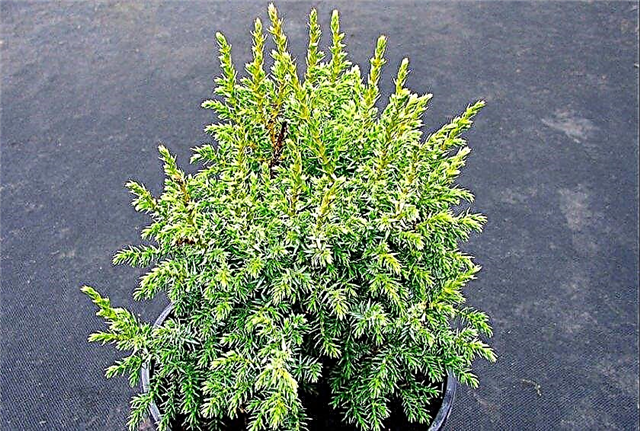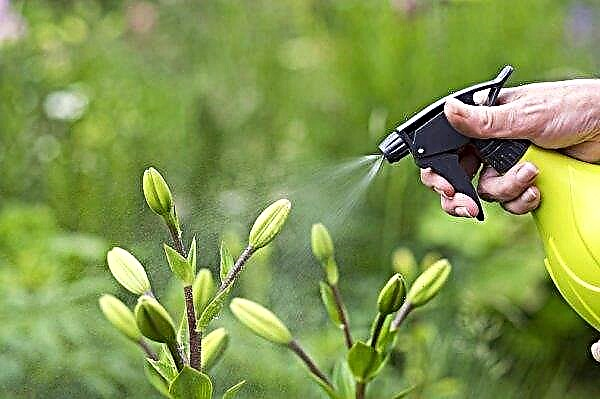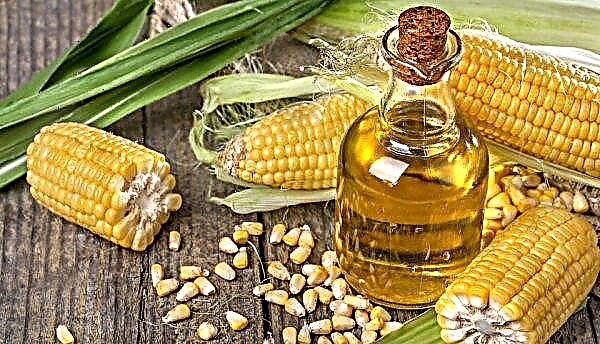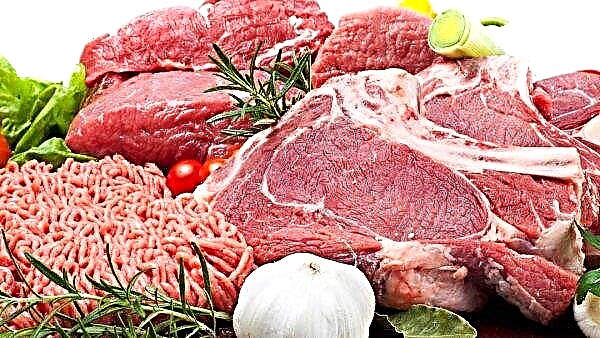Being almost the same age as our century, tomato Demidov in a fairly short time managed to earn an excellent reputation with both amateur vegetable growers and professionals. Read about the features of this tomato variety and about caring for it later in the article.
Tomato Features
Demidov belongs to the middle-ripening tomato varieties. The vegetation period from the appearance of the first full-grown seedlings to the ripening of tomatoes fits into the time interval of 101-110 days. This determinant variety develops weakly branched bushes up to 65 cm high.
Did you know? Although at the end of the century before last the US Supreme Court sentenced tomatoes to be called vegetables, at the beginning of this century the European Union obliged its citizens to consider tomatoes as fruits.
A slight branching of the variety allows not to resort to pruning bushes, which are covered with green leaves of a dark shade, in shape resembling potato. The rounded fruits are saturated pink in color, the weight of which varies from 80 to 120 g, characterized by a characteristic tomato taste, sweetness and juiciness. In addition, Demidov tomatoes have a good keeping quality.
The yield of the variety can reach almost half a ton per hectare, but under less favorable conditions it is limited to 150 centners per 1 ha. But 98% of the crop is marketable. In addition, the described tomato variety is cold-resistant, tolerates temperature fluctuations and is resistant to diseases characteristic of nightshade crops.
- The few disadvantages of Demidov tomatoes include:
- susceptibility of fruits to cracking during improper watering;
- susceptibility of fruits to apical rot due to insufficient watering.
Soil and climate requirements
Like all tomatoes, the Demidov variety prefers a slightly acidic soil containing a large number of micro and macro elements, especially in the form of phosphorus and potassium. Light loams or sandy loam soils enriched with humus are best suited for this.
The optimum temperature for the successful development of this plant lies between + 22 ° C and + 24 ° C. And although Demidov is well adapted to temperature fluctuations, when the temperature drops below + 15 ° C, the flowering process slows down, and the temperature above + 35 ° C completely stops it.
Important! Tomatoes grow best in beds, where earlier their predecessors were cabbage, cucumbers, corn and legumes.
Tomatoes are very intolerant of high humidity, which significantly slows down the process of pollination of flowers and leads to lower yields. Tomatoes feel best in the humidity range between 45% and 70%. During fruit ripening, moisture is preferable in the range of 65–70%.
The technology of growing tomato Demidov
This variety, not being hybrid, allows you to use your own seeds for propagation. The process of growing tomatoes is not very difficult.
Seeding and seedling care
Typically, seeds of this tomato variety are sown in March or April. The timing depends on where the seedlings will be planted, since it is transferred to greenhouses in May, and to open ground in June. Seeds are planted to a depth of 5 to 10 mm in a substrate consisting of:
- 70% of garden land;
- 15% humus;
- 15% sand.
A small amount of peat or sawdust and wood ash is added to this mixture. The substrate is placed in:
- plastic cups with a height of at least 10 cm;
- wooden boxes of the same height;
- plastic containers;
- cardboard pots;
- peat pots.
Did you know? Among the 10 thousand varieties of tomatoes that currently exist, there are not only traditional red, but also pink, green, yellow and even black.
Peat tablets are increasingly used for sowing seeds, in which the necessary nutrients are pressed together with peat. After sowing, the containers are covered with glass or a transparent film to create a greenhouse effect and left in a moderately lit place at a stable temperature of + 25 ° С. Shoots appear in the time interval between 5 and 10 days. After this, the containers freed from the coating are transferred to a well-lit and cooler place with a temperature of up to + 17 ° С.
After a week, the temperature is brought to a comfortable + 23 ° C. After the appearance of the second leaf on the shoots, the seedlings growing in boxes or containers are dived. Sprouts in cups or peat tablets do not require picking. A week before the seedlings are transferred to the open ground, they begin to temper it, starting with a couple of hours in the open air and gradually increasing this time.
Transplanting
The optimal time for planting seedlings in open ground is determined by its age, which should be from 60 to 65 days. By this time, plants already have 5-7 full leaves. Since the Demidov variety forms compact bushes, per 1 sq. Km. m can accommodate up to 6 seedlings. A planting scheme is also used, in which the distance between the seedlings is half a meter, and the spacing between rows reaches 0.6 m. After planting, the seedlings are moderately watered and after that the soil around the bushes is loosened.
Care
Watering tomatoes requires a delicate approach, since these plants equally do not tolerate both soil moisture less than 70% and stagnant water in the soil. Sufficient soil moisture in the first days after the transfer of seedlings from open ground is especially relevant, as a result of which moderate watering during this period must be done daily. In the phase of fruit ripening, attention should be paid to the regularity of watering. Sharp transitions from drying out the soil to copious moisture lead to cracking of the fruit. A chronic decrease in soil moisture can cause vertex rot on the fruit. This is due to the fact that the green mass of the plant, which is in need of moisture, begins to take moisture from the fruits, as a result of which the top part of the tomatoes softens and becomes easy prey for putrefactive fungi.
A chronic decrease in soil moisture can cause vertex rot on the fruit. This is due to the fact that the green mass of the plant, which is in need of moisture, begins to take moisture from the fruits, as a result of which the top part of the tomatoes softens and becomes easy prey for putrefactive fungi.
In addition to competent watering with warm water, during the growing season, these vegetables also need regular fertilizing. During the active growth of green mass, plants first of all feel the need for nitrogen, which is very much in organic fertilizers. During flowering, fruit setting and their development, the bush already needs phosphorus and potassium to a greater extent.
Important! The best way to moisten the soil on beds with Demidov tomatoes is drip irrigation.
Universal feeding, which satisfies the needs of the plant sufficiently, consists of water dissolved in a bucket:
- liquid cow manure - 500 ml;
- potassium sulfate - 5 g;
- nitrophosks - 20 g;
- superphosphate - 30 g.
During feeding, carried out at least three times during the growing season, under each tomato bush make up to 1 liter of this fertilizer. In addition, foliar nutrition of tomatoes is carried out by spraying the green mass of the plant with solutions of drugs:
- Megafol;
- "SWEET";
- "Brexil Ca";
- Gumifild.

Features of the hydroponic method
The surface root system characteristic of tomatoes allows them to be successfully grown through hydroponics. This method involves filling small containers:
- slag;
- crushed stone and gravel of small fraction;
- moss;
- expanded clay;
- coarse sand;
- coconut flakes;
- mineral wool.
 Small containers with the above fractions are placed in more spacious, filled with hydroponic solution. It consists of complex fertilizers that are balanced to a gram. The solution is most often purchased at specialized retail outlets, since self-adjusting the ingredients to the nearest gram is quite time-consuming. When using the hydroponic method, the temperature is maintained in the range from + 21 ° С to + 24 ° С and intensive lighting is used.
Small containers with the above fractions are placed in more spacious, filled with hydroponic solution. It consists of complex fertilizers that are balanced to a gram. The solution is most often purchased at specialized retail outlets, since self-adjusting the ingredients to the nearest gram is quite time-consuming. When using the hydroponic method, the temperature is maintained in the range from + 21 ° С to + 24 ° С and intensive lighting is used.- The benefits of growing tomatoes using hydroponics include:
- noticeable savings in planting space, fertilizers, water;
- the active development of plants, which contributes to the maximum assimilation of all nutrients by them;
- high productivity;
- good presentation of the fruit;
- saving time spent on caring for plants.
- The disadvantages of this method are:
- fairly high cost of hydroponic system equipment;
- a very large dependence of its regular functioning on the quality of the solution;
- the difficulties of combating diseases and pests.
Growing tomato trees in open ground
Belonging to undersized and weakly bushy tomato varieties, Demidov does not need much effort to form bushes. Most often they stepchild, leaving 2–4 stepson. However, this is not always done. Removing stepsons on stunted bushes very often leads to a noticeable decrease in productivity. But at the same time, the ripening of the fruits is accelerated, their presentation is improved and the size is increased, therefore, in each individual case, vegetable growers decide whether to plant a specific bush or not. Low-growing determinant tomato bushes usually do not need a garter. However, in the case of the described variety, which, having a high yield, can not withstand the weight of its own fruits, it is recommended to tie the bushes to reliable supports.
Low-growing determinant tomato bushes usually do not need a garter. However, in the case of the described variety, which, having a high yield, can not withstand the weight of its own fruits, it is recommended to tie the bushes to reliable supports.
Each watering of the plant should be accompanied by mandatory loosening of the soil around the bushes in order to avoid the formation of a crust that impedes the respiratory function of the root system. The same should be done after every rain. To stabilize the humidity and temperature conditions in the soil, it is recommended to mulch the soil around the bushes with straw, mowed grass or sawdust.
Possible growing problems
As already mentioned, Demidov tomatoes are resistant to diseases associated with nightshade crops. However, in case of violation of agrotechnical rules, irrigation can be affected by vertex rot. Prevention and treatment of this disease consists in timely watering of tomato bushes. Successfully confronts Demidov and pests.
However, a plant weakened by violations of the same agricultural practices can still be attacked:
Harvesting and storage
Crop of tomatoes Demidov, which reaches 10 kg per 1 square. m, they begin to collect immediately when a pink color appears on the first fruits. And to increase productivity, experts recommend removing unripe fruits from the bushes. They perfectly reach the condition without loss of taste and presentation in the room, and due to the resulting savings in nutrients, new full-fledged fruits will grow on the bush. The large size of the fruits of this variety makes them unsuitable for canning, but they are great for fresh consumption.
Their density allows you to move tomatoes over long distances. In addition, the fruits of Demidov tomatoes are distinguished by good stubbornness, which allows them to be stored for a long time. Tomatoes of the Demidov variety have gained great popularity among vegetable growers due to their high consumer qualities and at the same time their ease of care, high yield and disease resistance.


